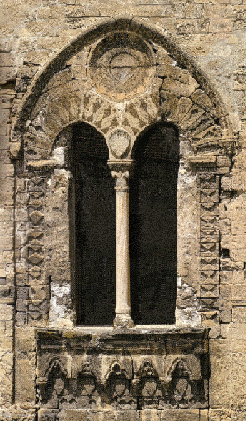...Best of Sicily presents... Best of Sicily Magazine. ... Dedicated to Sicilian art, culture, history, people, places and all things Sicilian. |
by Carlo Trabia | ||
Magazine Index Best of Sicily Arts & Culture Fashion Food & Wine History & Society About Us Travel Faqs Contact Map of Sicily |
We have fallen into the habit of calling these creations "Gothic" windows. Strictly speaking, however, the two-light window is an architectural element less Gothic than Romanesque. It's part of the heavy supporting wall of a castle, palace or church. To understand its history we must consider the origin of the Romanesque and its relationship to the Gothic movement. The Romanesque flourished from the ninth century until the eleventh century in Europe and some Mediterranean regions, its name drawn from the Roman architecture that influenced it. Heavy columns and thick walls supported wooden or simply-vaulted stone ceilings, and towers were massive. Arches were typically rounded rather than pointed. Windows allowed limited light into these buildings, leaving an impression of shadow. Northern Europe is usually associated with the Gothic, but in fact numerous Romanesque structures are preserved there. The Normans' first churches in England were Romanesque --Saint John's Chapel in the Tower of London is an example. In England the simple rounded Romanesque arch is sometimes called a "Saxon" arch. The Byzantine churches of Sicily were essentially Romanesque in style, and an early "Proto-Romanesque" is seen in the cathedral of Siracusa (in eastern Sicily), literally built into what was formerly a Greco-Roman temple whose pillars are still visible in the walls. The architecture of Palermo's tiny but beautiful San Cataldo Church (next to the Martorana near the Quattro Canti) is Romanesque. Speaking very generally, the Gothic style, which began to evolve in western Europe late in the twelfth century, preserved something of the Romanesque but emphasized higher buildings supported largely by external buttresses and slender pillars, with the expansive walls left for decoration rather than support of the vaulted ceilings. This allowed for large glass windows to better illuminate the internal areas; stained glass eventually became popular. The widespread introduction of pointed arched portals and windows, and tall towers or pointed spires, typified the Gothic, particularly in ecclesiastical architecture, though civil and residential architecture were also influenced. The pure Gothic never became very popular in southern Italy, though a style sometimes called "Romanesque-Gothic," incorporating pointed arches and rose windows, developed in the fourteenth century, supplanting the pure Romanesque. In Sicily the only remaining medieval Gothic church is Saint Mary of the Germans (Santa Maria Alemanna), now in ruins, built in Messina around 1194 on orders of Holy Roman Emperor Henry VI, who became King of Sicily. Cefalù Cathedral, begun in 1131, though Romanesque, has certain early Gothic features then popular in Normandy, such as pointed arches, a long narrow nave and high vaulted ceilings. Its towers have two-light windows. The distinctive but short-lived Norman-Arab style was part of the Romanesque order, and some later Norman-Arab structures have two-light windows. In places such as Palermo's large historical district, the two-light windows make it easy to identify buildings as being medieval long after they have otherwise been modified beyond recognition. In Taormina the arched windows are seen in many structures. These windows on the soul are also windows into the past. About the Author: Architect Carlo Trabia has written for various magazines and professional journals, as well as this online magazine. | |
Top of Page |
 Windows into the soul of Sicily. They're all over medieval Sicily. In the walls of buildings in hidden narrow streets, in churches, in castles and palaces. In Palermo, Catania, Siracusa, Taormina. Popularized during the Norman era, the two-light window was a fundamental element in medieval European architecture. The Arab ("Moorish") decoration of Sicily's arched two-light windows may be slightly more ornate than what you'll encounter in northern Europe --and more akin to the Spanish interpretation-- but the basic style was used across Europe and the Mediterranean world. Until the fourteenth century, most of the windows in Sicily's important buildings were constructed in this simple but beautiful style. Fortified dwellings (like the one shown here) and even churches sometimes included both arched two-light windows and slit loopholes, combining the need for light with the need for defence. This is an equilateral arch supported by a central "mullioned" column. The Italian term is "bifora."
Windows into the soul of Sicily. They're all over medieval Sicily. In the walls of buildings in hidden narrow streets, in churches, in castles and palaces. In Palermo, Catania, Siracusa, Taormina. Popularized during the Norman era, the two-light window was a fundamental element in medieval European architecture. The Arab ("Moorish") decoration of Sicily's arched two-light windows may be slightly more ornate than what you'll encounter in northern Europe --and more akin to the Spanish interpretation-- but the basic style was used across Europe and the Mediterranean world. Until the fourteenth century, most of the windows in Sicily's important buildings were constructed in this simple but beautiful style. Fortified dwellings (like the one shown here) and even churches sometimes included both arched two-light windows and slit loopholes, combining the need for light with the need for defence. This is an equilateral arch supported by a central "mullioned" column. The Italian term is "bifora."